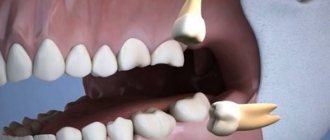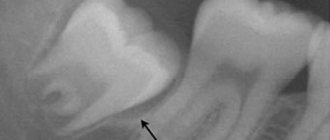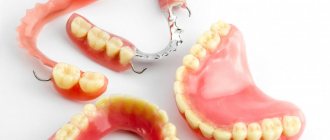A wisdom tooth is a rudiment, that is, an organ that has lost its significance during the period of evolutionary development of the body. Nowadays, the wisdom tooth does not provide any useful functions for a modern person. However, wisdom teeth continue to form in the body during the fetal state and remain throughout life. The growth of wisdom teeth can be caused by several factors, one of which is pregnancy.
During pregnancy, processes of restructuring metabolic processes occur in the mother's body. This provokes the appearance of a wisdom tooth. The appearance itself does not have negative consequences, provided that the tooth grows correctly. Often a wisdom tooth grows in the wrong direction, which is what causes discomfort and difficulty in treatment.
Symptoms of an erupting wisdom tooth:
- Pain affecting the ear and jaw area;
- Pain when talking, closing the jaws;
- Sharp and strong shooting in the gums in the area of the eighth tooth;
- Injury to the cheek, cuts. Especially when a wisdom tooth appears on the upper jaw;
- Swelling of the mucous membrane and inflammation of the gums in the area of the eighth tooth;
- Increased temperature accompanied by headache;
- Discomfort when chewing and swallowing;
- Persistent bad breath.
Pain as wisdom teeth grow can be throbbing and aching. The pain is worse at night than during the day. A pregnant woman feels discomfort especially when chewing food. In difficult situations and when treatment of wisdom teeth is delayed, the lymph nodes become inflamed. In such cases, the patient needs to urgently visit the dentist.
Extraction during pregnancy: pros and cons
The rapid eruption of the third molar in pregnant women is facilitated by hormonal levels, which enhance blood flow and activate metabolic processes in the body.
Pain during the eruption of the third molar can be severe, because during pregnancy:
- irritability of the nervous system increases;
- gums become swollen and inflamed;
- Due to vomiting in the first trimester, gastric juice damages the oral mucosa.
From the article on the website Stom-Firms.ru you will find out whether it is possible to remove a wisdom tooth during pregnancy, what complications there may be, and how to relieve toothache.
Implantation and prosthetics during pregnancy
Prosthetics in themselves are not prohibited during pregnancy. You can install removable and fixed dentures, and even crowns. But implantation will have to wait until the baby is born. Dental implantation during pregnancy requires a huge expenditure of vitality and body resources, and most importantly, the use of anti-inflammatory drugs, strong painkillers, and sometimes antibiotics.
Inserting an implant into bone tissue requires surgical cutting of the gum and drilling into the bone. And then the body must form new bone tissue around the implant. And all this during the period when the skeleton of the unborn child is intensively formed, when every milligram of calcium counts - so much so that the mother’s body is ready to weaken its own bone tissue and the structure of the enamel and dentin of the teeth so that the baby’s body does not experience a lack of calcium.
Therefore, during such a period, it is extremely unwise to further weaken the mother’s body and endanger the unborn child through the most complex surgical implantation operation. It is better to wait a few months and have implantation done after birth, without endangering the baby.
When is a wisdom tooth removed during pregnancy?
Since X-rays are contraindicated for pregnant women, the condition of the third molar is assessed using a radiovisiograph. The device gently irradiates the patient and converts the X-ray signal into a digital image.
If the “eight” grows vertically and there is enough space in the jaw for it, the dentist cuts the gum “hood” and facilitates eruption.
Removal during pregnancy is indicated when:
- It grows incorrectly;
- Compresses the roots of the adjacent molar;
- Provokes severe pain;
- Causes pulpitis and periostitis.
The period from 15 to 22 weeks is suitable for figure eight extraction. At this stage, the process of laying the fetal organs is completed, and the activity of the placenta is maximum - it does not allow the drugs that the dentist uses for pain relief and local treatment to pass through. In case of purulent inflammation, emergency surgery is performed in any trimester, because the infection can penetrate the placenta and affect the fetus.
In pregnant women, the dentist uses lidocaine, articaine and mepivacaine as anesthesia. The choice of drug depends on the timing and individual sensitivity of the patient. In order not to administer a large dose, to increase the time of pain relief and to prevent bleeding, the anesthetic is diluted with a vasoconstrictor. It is not advisable to use it at 1, 2 and 9 months of gestation, as it can cause uterine spasms, disrupt intestinal function and increase blood pressure.
Growth symptoms
Before you understand what to do when your wisdom tooth is inflamed and hurts, or whether to take a painkiller, it is worth identifying the provoking factors and accompanying signs. The most common symptoms are:
- Pain syndrome. It signals the possible onset of the inflammatory process.
- Swelling, inflammation. At first they are localized at the site of the appearance of the molar, then they progress and cover the cheeks, ears, temples, and neck.
- Increased body temperature. In most cases, low-grade fever persists.
- Unpleasant sensations when swallowing food, drinks, discomfort while chewing food. It is impossible to fully open your mouth.
- Inflammation of the lymph nodes, pain when pressed.
How to numb a wisdom tooth during pregnancy
You need to ensure that infection does not penetrate the gums: brush your teeth thoroughly and try not to chew on the side of the growing “eight”. To avoid damaging your gums, you should avoid rough foods and spices. You cannot use folk remedies for treatment, since many herbs are contraindicated for pregnant women. You should absolutely not rinse your mouth with alcohol solutions or place garlic on your gums. They irritate the mucous membrane, cause burns and increase pain.
If your dentist delays wisdom tooth removal until the second trimester, pain can be relieved in the following ways:
- Avoid very hot and very cold drinks and food;
- Rinse the mouth with warm saline solution;
- Take baths with chamomile infusion, soda or chlorhexidine solution;
- Apply a cold compress to your cheek for 15-20 minutes.
Dentists do not recommend using painkillers until the 12th week of pregnancy, when the placenta is still forming and medications can disrupt the development of fetal organs. But if the "eight" causes severe pain, the doctor may prescribe solutions or sprays with benzocaine or anti-inflammatory tablets by mouth.
What to do before going to the doctor
Trying to deal with pain on your own is prohibited. But if a specialist has confirmed that the eruption of bone tissue proceeds according to the classical pattern, you can calm down.
Pain can be reduced by following some rules:
- Chewing food should take place on the “healthy” side.
- After each meal, you need to rinse your mouth with special products, which you can purchase at the pharmacy or make yourself from medicinal herbs. Sodium bicarbonate diluted with water will also be effective for rinsing.
- It is allowed to take pharmacological agents, but only after consultation with an obstetrician. Drotaverine or Ibuprofen would be acceptable.
Complications after wisdom tooth removal in pregnant women
Pregnant women try not to remove the “eights”, since after the operation alveolitis often develops - infection of the bone socket. Due to the restructuring of the immune system, the mucous membrane has difficulty resisting bacteria; they easily penetrate the postoperative wound and periosteum, causing periostitis. At the same time, the body temperature rises, the pregnant woman’s well-being worsens, which negatively affects the growing fetus. Treatment of alveolitis and periostitis will require antibiotics, which can harm the unborn child.
Another reason to delay third molar extraction is the risk of bleeding. If the patient has chronic oral diseases, vitamin deficiencies, or is taking blood thinning medications, it will be difficult for the dentist to stop the bleeding after removing the figure eight.
Oral care after surgery
If surgical intervention could not be avoided, all that remains is to strictly follow all the dentist’s recommendations so that the mucous membrane recovers faster. For some time, the woman must follow the drawn up rehabilitation scheme, and also monitor the cleanliness of her teeth and oral cavity.
Care consists of several points:
- The dentist places a cotton swab on the operated area. It needs to be changed every half hour, it all depends on the intensity of blood flow. Read more about how to stop bleeding after tooth extraction here.
- After the intervention, all bone tissue cannot be cleaned for exactly one day. The same applies to the use of rinses. Otherwise, this may negatively affect the period of rehabilitation and healing of sutures. It is highly undesirable to suture the mucous membrane again.
- Over the next few days, it is important to minimize your intake of solid foods and hot drinks.
- After 72 hours, you can use dental floss, and it is also important to clean your entire mouth.
- After about 7 days, the stitches will come apart and you can return to normal life.
What happens if your wisdom tooth is not treated during pregnancy?
Severe pain during the eruption of the figure eight increases the level of adrenaline in the blood of a pregnant woman. It causes spasm of the muscles of the uterus and arteries, so with toothache, pregnancy can occur with complications.
The following consequences are also possible:
- Pericoronitis. The gingival “hood” above the wisdom tooth becomes inflamed more often, because in pregnant women the antimicrobial activity of saliva decreases and carious processes accelerate.
- Periodontitis. When the sharp edges of a molar cut into the gums, bacteria and food particles enter the wound, and pus accumulates under the gum. If pericoronitis is not eliminated in time, the infection spreads to the periodontium. Periodontitis causes bleeding gums and can increase the mobility of adjacent teeth.
- Periostitis. If the roots of the “eight” are destroyed, the inflammation spreads to the periosteum of the jaw, which contains many nerve endings. With purulent periostitis, toothache intensifies, body temperature rises sharply, and pus can enter the retropharyngeal space and cause blood poisoning.
Since mineralization of the teeth and bones of the fetus begins in the middle of pregnancy, the expectant mother’s enamel weakens, and the “eight” is quickly destroyed due to caries. If the third molar grows incorrectly, it puts pressure on the roots of the neighboring “seven”, destroying its enamel and can cause pulpitis.
The best option is to remove a wisdom tooth during pregnancy planning or in the postpartum period, when the doctor can take an x-ray and evaluate the condition of the “eight” without the risk of harming the fetus. To prevent inflammation, in the second trimester the dentist performs professional oral hygiene using ultrasound.
Prohibited actions
These actions cannot be taken under any pretext, they are strictly prohibited and can cause abnormal embryonic development:
- Use of analgesics. Applying painkiller tablets to the eight. On the Internet you can read about the method of applying Ketanov to the inflamed area. In the case of eights, this will only increase inflammation and the appearance of purulent wounds. In addition, this drug is strictly prohibited during gestation.
- Heating in the area of the diseased tooth. It is forbidden to apply heat to the area of inflammation (heating pads, socks with salt, etc.). Heat will increase blood flow to the figure eight and accelerate the development of a purulent bladder.
- Self-medication. Self-medication during gestation is extremely undesirable. Only a dentist can determine the correct diagnosis, clinical picture and draw up a treatment plan.
Find out more on the topic
We have collected more materials for you on whether it is possible to remove wisdom teeth during pregnancy:
- Removal of a tooth
- Removal of an impacted tooth
- Computed tomography of teeth
References for the article:
- Anisimova E.N., Aksamit L.A. and co-authors “Algorithm for providing dental care to pregnant women” // Endodontics Today - 2015.
- Lingam Amara Swapna, Entessar Zeyad Mohammad Alanazi et al "Awareness of Dental Interns to Treat Pregnant Patients" - 2019.
Author of the article: Mariam Arutyunovna Harutyunyan
Copywriter of the information portal Stom-Firms.ru. Specialization in translations and original articles on medicine and dentistry.
Treatment
In dental practice, only 3 methods of treating wisdom tooth inflammation are used:
- Hood cut. A minimal incision in the gum is made over the bone tissue. This avoids the accumulation of pus and facilitates the eruption of bone tissue.
This method is shown only in cases where others are prohibited.
- Excision. If, after an x-ray, the dentist is convinced of the normal structure of the bone tissue, he completely excises the upper ball of the mucous membrane that covers it. The procedure is extremely unpleasant and poorly tolerated during gestation, but it allows you to save the tooth.
- Removal of a tooth. A relevant option when the use of other methods is irrational or contraindicated. This treatment regimen is used when bone tissue interferes with other teeth or is in an incorrect position and can displace the jaw.
Traditional medicine recipes
There are products that have been highly effective for decades. They do not help cope with severe cases, but provide invaluable assistance in eliminating pain and other signs of the pathological process.
Anesthetic solution
To prepare the healing composition you will need:
- clean boiled water (1 liter);
- a tablespoon of sea salt;
- 100 g of ammonia;
- 10 g camphor alcohol.
All ingredients mix well. Then a cotton pad is moistened in liquid and applied to the sore spot for 20 minutes. Regardless of how long the wisdom tooth hurts (how to relieve pain in advanced situations is discussed above), this anesthetic composition temporarily improves the patient’s condition and allows him to take a little rest from the torment before visiting the dentist.
Onion peel
All you need to do is take a few medium onions and boiling water. The peeled outer shell is poured with 0.5 liters of boiling water, the container is hermetically sealed and set aside in a dark place for about an hour.
After the specified time has passed, you need to take 2-3 tablespoons of infusion into your mouth and hold it, without swallowing, for 15 minutes. The procedure should be carried out up to 5 times a day. The product helps relieve teething symptoms and stop the progression of inflammation.
Aspen in pain
This decoction will provide invaluable help when the wisdom tooth in the upper jaw hurts, the gums are swollen and the face is swollen. It is necessary to pour aspen bark or shavings (20 g) with a glass of water, bring to a boil and boil for half an hour. Then the mixture is infused for the same amount of time to cool and filtered. You need to rinse your mouth with this liquid every time after eating.
Healing mixture
You should take:
- 15 drops of iodine;
- a teaspoon of salt;
- 1 tbsp. aloe juice (freshly squeezed).
The components are dissolved in 250 ml of clean boiled water, the mixture is brought to homogeneity. It is recommended to rinse the mouth about 3 times a day.










